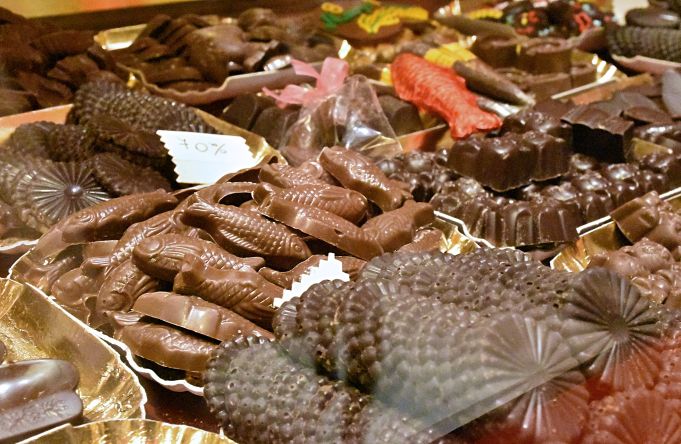Tradition and quality are key ingredients at three of Rome's artisan bakeries.
BISCOTTIFICIO ARTIGIANO INNOCENTI: Three generations of biscuit specialists
On a narrow street in Rome’s Trastevere neighbourhood, the blending of gastronomic and family traditions can be tasted, and it tastes delightfully sweet. Since 1940, the Innocenti family has owned the Biscottificio Artigiano Innocenti, a biscuit factory now run by Stefania Innocenti (pictured above), third generation of biscuit specialists.
The Biscottificio operates on the ground floor of a charming house. Colourful biscuits are displayed all across the counter, an overwhelming display that makes it hard to pick and taste only one kind. The protagonist of the place, however, is an oven, approximately 15m long, especially tailored and built in situ during the 1960s.
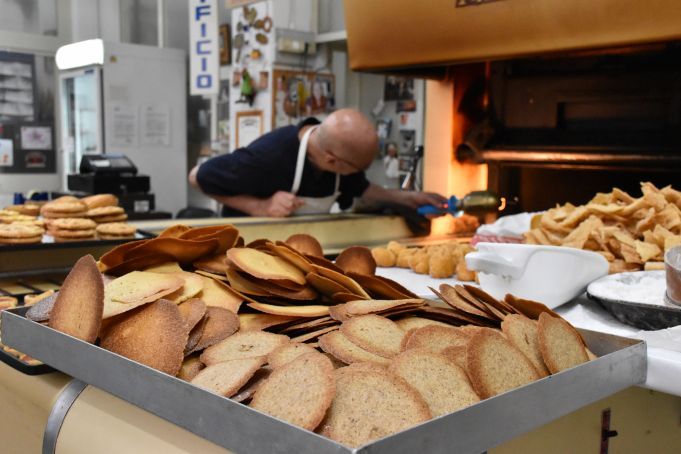
“This oven is a perfect machine,” says Stefania. It possesses a gear wheel to control the speed of the surface where the biscuits are baked while sliding from the kitchen into the shop. “Mamma is the soul of this business and this oven is the heart of the shop,” Stefania tells me with a smile while insisting that I try a warm castagnola.
Countless kinds of biscuits have been baked in this shop. Stefania’s grandfather used to tell her about producing massive quantities of biscuits that were used as rations for soldiers during the world war two. Later on, Stefania’s parents started experimenting with different ingredients. While the traditional recipes have always been appreciated and respected, new ones started coming up and claiming their space too. The only condition has always been a commitment to fresh, carefully-selected ingredients. No preservatives and no animal fat are used. Currently, Stefania tells me, she wouldn’t even be able to count how many types of biscuits she bakes each day. But she estimates an average of 60 different kinds of flavours and shapes, each one of them still completely hand-made.
A timeless photo of her mother hangs on one wall, where the Biscottificio surrounds her in seemingly identical conditions as those of today. Stefania remembers helping her parents as a little girl, putting biscuits into paper bags and handing them over to costumers. Working there has come naturally. “It was a given, I suppose,” she tells me with a content smile.
The key to every single biscuit’s turning out delicious and unique is not only the cautious selection of the ingredients, but also the assortment and well-being of the staff. After all, Stefania believes that great baking is not achieved through talented hands and the right ingredients alone, but also through putting enough heart into the work. The harmony among her team is crucial: “If this place is like home, they are like my family,” she says. It does indeed seem that she is right at home, and everyone who walks in is kindly invited into her delicious-smelling kitchen.
MORIONDO & GARIGLIO: A century of secret chocolate recipes
A discreet door at Via del Pie' di Marmo 21 opens the way to an elegant confectionery with a longstanding history. Moriondo & Gariglio is named for the two cousins who started this business in 1850 in Turin. This chocolate factory was the first to move to Rome in the 1870s, just when Rome was becoming the capital of the newly-unified Italy. Its recipes have been a secret for over 100 years, passed on by word of mouth from its creator up to the current chocolatier, Attilio Proietti, who manages operations with his mother, Piera Minelli.
Walking in, one is immediately hit by a sense of sophistication and the smell of chocolate. Piera Minelli stands behind a chocolate-filled counter carefully wrapping each treat by hand. She says proudly that in the 19th century, when Moriondo & Gariglio moved to Rome, a renowned chocolatier from Turin called Carlo Enrico Cuniberto took charge of the establishment. She calls him “the master chocolatier”. It was he who solidified Moriondo & Gariglio’s reputation for excellence and invented the recipes, still in use, which reach for complex flavours through simplicity. Only a handful of fresh and natural ingredients have ever been used here.
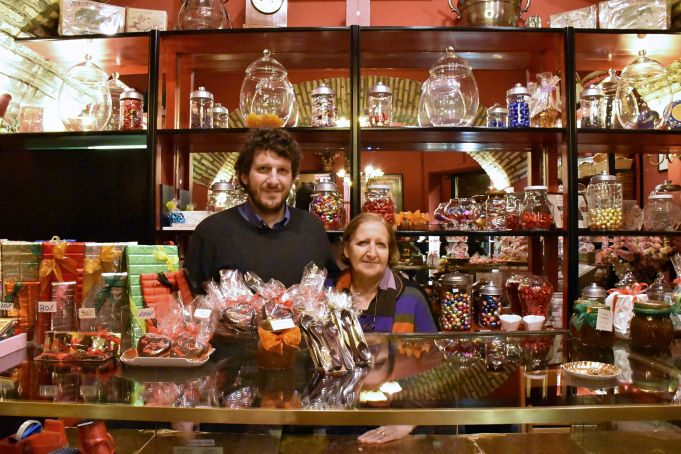
The passing on of tradition at Moriondo & Gariglio started in 1943, when 12-year-old orphan Marcello Proietti arrived at the establishment to work serving tables. The master chocolatier, who did not have children, adopted Proietti by initiating him into his art and confiding his secret recipes. Piera Minelli arrived at Moriondo & Gariglio in 1965, and became Proietti's business and life partner. It is their son Attilio Proietti who now carries on the chocolate tradition and keeps the secret recipes alive.
To Piera Minelli, the seasons start in October "with marrons glacés, our specialty”. Torrone and chocolates assume pine-tree shapes at Christmas, and then heart shapes on St. Valentine's Day. In March, yellow marzipan imitates mimosa flowers. At Easter, personalised chocolate eggs conceal gifts, an idea from the master chocolatier in the 1900s. Aside from the seasonal treats, an average of 30 to 60 kinds of chocolates are produced at Moriondo & Gariglio daily, all deriving from the master chocolatier's recipes.
Walking in at door number 21, one is invited to taste through palate, smell and sound with Minelli's stories from the early 1900s, when the master chocolatier first crafted cactus-shaped marzipan sharing a worktable with his friend, the Roman dialect poet Trilussa. Within Moriondo & Gariglio's own oral traditions, recipes are kept secret but great historical tales are offered on the house while the chocolate treats speak for themselves.
LA DOLCEROMA: Austrian and American specialties with quality ingredients
A passion for sweets and a concern for healthy eating don't often appear in the same sentence, but they epitomise Stefano Ceccarelli, owner and chef of La Dolceroma. In his small workshop in the Jewish ghetto neighbourhood of Rome, Ceccarelli has been working for 30 years to create Austrian and American specialties from quality ingredients such as coconut sugar, organic flour and oats, free-range eggs and biodynamic apples.
At Via Del Portico d’Ottavia, an American flag hangs on a door. “La Dolceroma” is written right above it, while the combined sight and smell of a counter filled with Austrian cakes and biscuits is mouth-watering, to say the least. One of the stars of his counter is the Sachertorte, a mouth-watering Viennese cake made of whipped chocolate and butter filled with apricot jam, for which Ceccarelli soon became known in Rome.
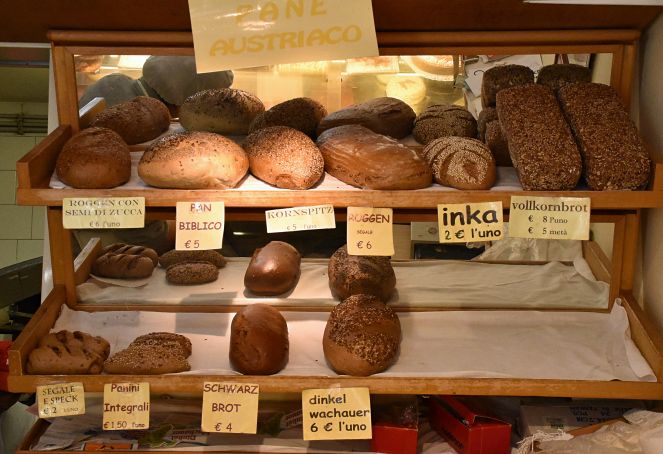
The mixture of American, Austrian and Italian elements at La Dolceroma is a reflection of the owner's life: Ceccarelli studied confectionery in Austria and in the USA, and his menu consists of traditional recipes from both these places, with a touch of Italian ingredients here and there, such as the celebrated hazelnuts from Viterbo.
La Dolceroma started as a support bakery to produce desserts for the restaurant next door. Soon enough, Ceccarelli had built a clientele of his own and the business developed into the successful confectionery that it is today. Right behind the counter, Ceccarelli and his two assistants move quickly and seamlessly in the small space that is his workshop.
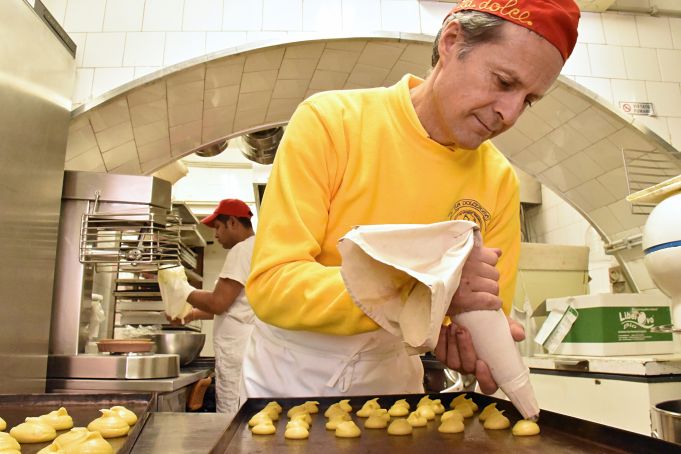
With a smiling face and fast-moving hands, Ceccarelli navigates the bakery world by preparing American cheesecakes, decorating an Austrian nusstorte (hazelnut pie), and frying some traditional Italian bigné di S. Giuseppe, all in a matter of minutes. Meanwhile, he talks in a mixture of English, Italian and German, referring to his specialties by their original names.
Stefano maintains proudly his production methods as they were in the 1980s, refusing to incorporate over-processed ingredients or rely on too many machines. He achieves traditional tastes through quality ingredients, producing a homemade feel that, paradoxically, makes eating out all the more special.
“I cook at La Dolceroma as if I were cooking at home for myself and for my family,” he says. Living proof of that are his four children, who all have grown up happily indulging in his creations at the confectionery.
Paula Berner Magalhaes
This article was published in the June 2017 edition of Wanted in Rome magazine.
Biscottificio Artigiano Innocenti, Via della Luce 21, tel. 065803926.
Moriondo & Gariglio, Via del Pie' di Marmo 21, tel. 066990856.
La Dolceroma, Via del Portico d'Ottavia 20/B, tel. 0645470303, www.ladolceroma.com.



